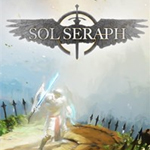Playing a god.
It is amazing that it has taken this long for someone to pay homage to the classic SNES game Actraiser, a game that combined two genres into one unique experience that simply never took off. Leave it to developer Ace Team to finally reignite the flame. Having been known for their weird and unique style of creation, this Chilean-based studio has some truly remarkable titles under their belt. SolSeraph might as well be the spiritual successor to the Actraiser series, as it apes almost everything that made it what it was, including the original composer, and brings it into the new generation. While it wears its inspiration on its sleeve, it falls short in execution thanks to some simplified game design and a severe lack of depth.
For those that have never experienced Actraiser, there is a reason it has such a cult following. It meshes two completely separate genres into one. One part of the game is a side-scrolling action title, while the other is a top-down world-building experience that combines city-building with tower defense. It is two entirely different genres that should not go well together, but they do. SolSeraph attempts to recapture that magic while also modernizing it for today’s standards.

MSRP: $14.99
Platforms: XB1 (reviewed), PS4, Switch, PC
Price I’d Pay: $14.99
Much like Actraiser, SolSeraph features a sole character that controls everything. Helios is a kind god, one that wants to rebuild his world and help his people. His goal is to help each area rebuild their world and defend it against the forces of evil. The opening cut scene sets the stage, but the rest of the game is delivered through written dialogue. It is serviceable, but never elevates the game past its generic status. This feels like any other story about a god and his people.
If Ace Team did one thing right, it was nail the feel of a SNES-era game. The side-scrolling sections are stiff and challenging. Enemies come in at weird patterns and it takes a bit to get used to the heavy movement and evasion Helios has. Everything is space and timing based, and requires retraining my brain to work within its world. Helios will get powers as the game progresses, but I never found anything as effective as the bow I started with. It deals good damage while also being ranged. I used it almost exclusively as long as I had magic for it.
These sections can fall apart through inconsistency. Some levels are short and sweet, while others are drawn out and long. It wouldn’t be so bad if the checkpoints were better spread out. Also sometimes an enemy will come out of nowhere and cause a quick death, resulting in starting a whole level over. It is incessant padding, especially when the game shines in shorter levels. Get in and out quickly without much fuss. More consistency or better checkpoints for the longer levels would have gone a long way.
As for the world building portions Ace has done an admirable job of bringing the design onto consoles. The menus are simple radial dials with basic buildings. Everything makes sense in context. Houses add units while wood is the starting tent pole for production. The game showed me everything it needed to then left me to discover how it works. Each map has its own unique set of criteria and the concept is always the same. Expand my area to remove the fog of war and destroy the spawns of my enemies. Once I uncovered them I could send Helios in to dismantle the area in a side-scrolling adventure.
Where this falls apart is that the depth presented isn’t needed. Once I learned how the spawns worked I could easily counter them with little effort. There are also resources and buildings I never bothered with simply because they were not needed. Then once I gained Helios’ power I could smite anyone nearing my campfire. It devolves into simplicity far too quickly. Granted it never dulled my enjoyment of the experience, it just did little to enhance it either.

With a history like the one Ace Team has, I expected more robust creature designs. The ones here are decent, but it still feels a bit mundane when compared to their previous efforts. The game has some seriously slowdown as well, even running on an Xbox One X, which is confusing as the game doesn’t seem to be doing anything too taxing. The music is the bright spot. Composed by Yuzo Koshiro, who handled the original Actraiser soundtrack, the sweeping music is really intoxicating. I loved the main theme, and it really sets the mood much more than the visuals do.
SolSeraph is a love letter to fans of Actraiser and feels like it should somehow contain the name in its title. Sadly, it falls short on several areas that keep it from resurrecting the genre like many hoped it would. Ace Team continues to be a developer I cannot take my eyes off of though. Their creations are unique in and of themselves, and always entertain me even when they fall short of that great status mark.
Review copy of game provided by publisher.
